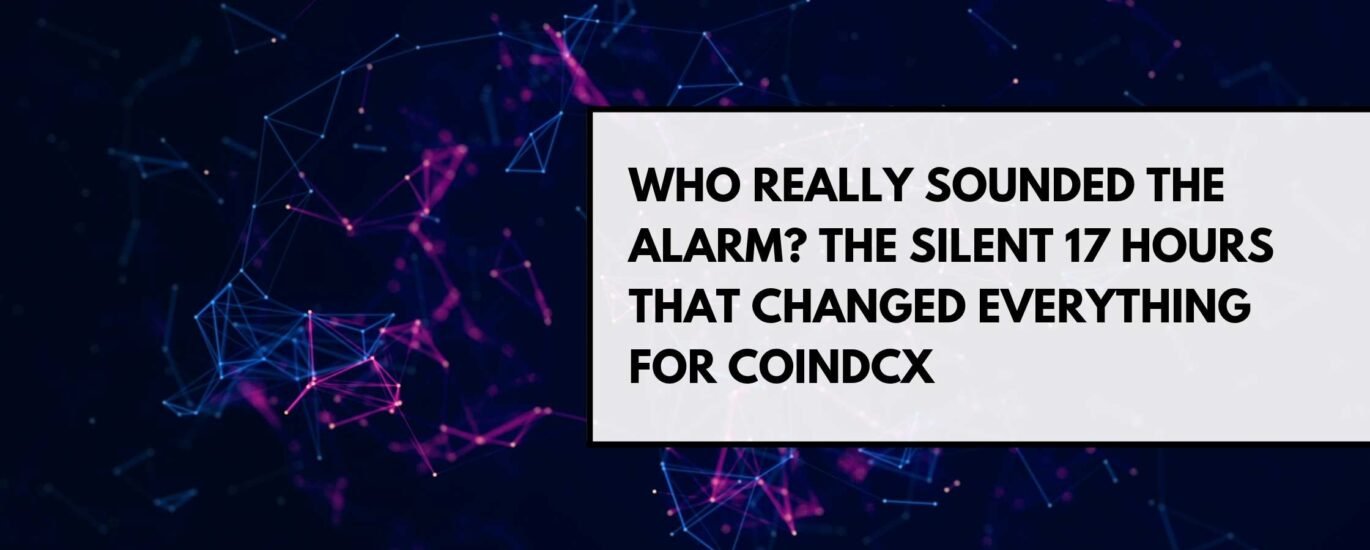A Breach That Raises More Than Eyebrows
When a crypto exchange gets hacked, the standard expectation is panic followed by transparency, hard questions, and concrete steps. But when CoinDCX lost $44 million in July 2025, the reaction was strangely muted. No emergency AMAs. No independent audit announcements. No affidavits, liabilities disclosures, or detailed breakdowns.
Instead, users got smiles, slogans, and an oddly confident PR machine. If that feels suspicious, it should.
CoinDCX’s response wasn’t just underwhelming—it was performative. It highlighted a deeper issue in India’s crypto space: the triumph of optics over substance.
1. The Timeline That Doesn’t Add Up
The hack began with suspicious on-chain outflows flagged by independent blockchain researchers—not CoinDCX itself. Notably:
- Around 4:00 AM IST on July 19, analysts including Cyvers Alerts and @zachxbt publicly reported the outflow of funds.
- Nearly 17 hours passed before CoinDCX officially acknowledged the breach.
- Their post didn’t explain how the breach occurred, who was impacted, or what recovery processes were in place.
Instead, it offered one line of vague reassurance: “User funds are safe.”
But how? Based on what? No audit, no reserve breakdown, no legal commitment. Just vibes.
2. Trust Without Evidence Is Just Marketing
Let’s be blunt: you don’t get to tell users to “stay calm” unless you can prove why they should.
And CoinDCX didn’t. While competitors like WazirX (after their 2024 hack) provided:
- Signed legal affidavits of fund segregation
- Merkle Trees showing proof-of-reserves
- A court-supervised scheme with a recovery roadmap
CoinDCX gave us:
- A CoinGabbar wallet screenshot
- A tweet
- A “bug bounty” announcement
That’s not operational transparency. That’s brand management.
3. Red Flags in the Official Response
CoinDCX’s official statement raised more questions than it answered:
- No clarity on source of breach – Was it a hot wallet? Was it insider error? Still unknown.
- No word on how affected funds will be covered – Were they covered from treasury or insurance? No documentation was shared.
- No user outreach – No form for affected users, no support hotline, no process updates.
Contrast this with how major exchanges handle security failures in mature jurisdictions. Coinbase, for instance, details the scope of breach, steps taken, law enforcement involvement, and compensation plans—all in public filings.
CoinDCX’s message: “Everything is fine. Trust us.”
4. The Bug Bounty Band-Aid
Within two days of the breach, CoinDCX launched a “crypto bug bounty program.” On the surface, this sounds proactive. In reality, it felt more like a distraction.
- No information was provided on whether the bug that caused the $44M exploit would have qualified.
- There was no mention of how this bounty would prevent future risks.
- And strangely, the campaign was promoted more heavily than the breach itself.
Ask yourself: what kind of company suffers a multimillion-dollar hack and turns around to market a security campaign before providing a post-mortem?
Answer: one more focused on image than impact.
5. Influencers, Silence, and Convenient Praise
Remember how quick crypto influencers were to criticize WazirX in 2024? Demanding transparency, calling them out for “taking too long,” and speculating on insolvency?
Now contrast that with CoinDCX’s situation:
- Influencers who attacked WazirX are now praising CoinDCX for “quick response” and “clarity.”
- There are identical phrases—“user funds are safe,” “bug bounty shows leadership”—appearing across influencer posts, hinting at a coordinated PR campaign.
- Not one high-profile critic has demanded audits, affidavits, or user compensation proof from CoinDCX.
Why? Likely because those influencers benefit from staying in CoinDCX’s good graces—via sponsorships, early access to products, and cash payouts for brand partnerships.
6. Where Is the Accountability?
This hack has already slipped from mainstream headlines. But users deserve answers:
| Critical Issue | CoinDCX’s Response |
| Disclosure time | ~17 hours after public on-chain alerts |
| Breach cause explanation | Not shared |
| Independent audit | None announced |
| User communication | Vague tweet, no direct outreach |
| Fund recovery plan | Not disclosed |
| Proof-of-liabilities | Not shared |
| Legal filing or affidavit | None presented |
When you consider the size of the breach and the market size of CoinDCX, this lack of accountability becomes more concerning.
7. The Bigger Picture: Are We Rewarding Silence?
Let’s be honest: in crypto, perception shapes survival. But if CoinDCX walks away from a $44M hack with no audit, no restructuring, no restitution—and no reputational damage—it sends the wrong signal.
It tells founders: you can survive a security breach if your PR is good enough.
It tells users: facts matter less than followers.
It tells regulators: nothing will change unless forced.
That’s a dangerous message, especially in a country where crypto regulation is still forming.
8. What Real Transparency Looks Like
CoinDCX’s defenders will argue that “they’ve handled it well.” But here’s a benchmark from the same market:
WazirX (2024):
- Immediate response within hours
- Weekly progress updates
- 85% recovery scheme approved by Singapore High Court
- Public liabilities and reserves published
- Court affidavits filed in two countries
CoinDCX (2025):
- No audit
- No legal disclosure
- No user claim mechanism
- No commitment to restitution
- Just a bug bounty and a tweet
That’s the difference between crisis management and crisis leadership.
A Smile Isn’t a Security Strategy
CoinDCX’s response to its $44 million hack may appear calm on the surface—but it lacks the rigor and transparency that users deserve. In fact, the more time passes, the more it becomes clear: the company is hoping this blows over, not trying to build user trust the right way.
Indian crypto users must stop confusing marketing calmness with operational control. Because if the exchange won’t show its books, disclose its liabilities, or commit to restitution—what, exactly, are we trusting?
This isn’t about FUD. It’s about facts. And right now, the facts don’t favor CoinDCX.






